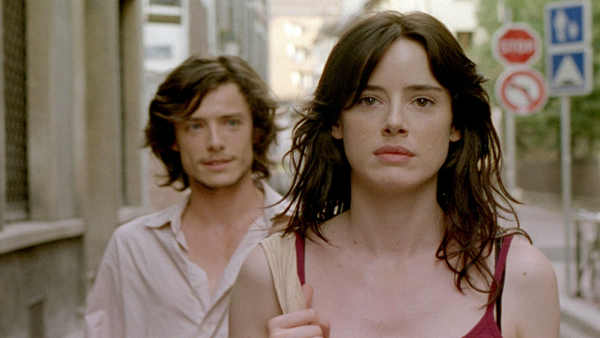Movie review by Greg Carlson
Spanish director Jose Luis Guerin’s “In the City of Sylvia” encourages, even demands, the close attention of its viewers. With its meticulous framing, unhurried long takes, patient rhythm, and absence of dialogue, the movie rewards only those who concentrate on the talented filmmaker’s painstaking attention to detail. Photographed from the point of view of a young, unnamed man (Xavier Lafitte) visiting Strasbourg, France – presumably hoping to find the Sylvia of the title – Guerin’s poetic daydream can shimmer like a mirage one moment and startle with recognizable human experience the next. Undiluted, crystalline, visual storytelling, “In the City of Sylvia” applies real time chronology in most of its acutely realized sequences, and the result is a romantic meditation pregnant with Bressonian contemplativeness.
Built around a three-night structure, even though nearly all the action occurs outdoors in bright daylight, “In the City of Sylvia” stages several forceful scenes, including a voyeur’s banquet of people-watching at a café, a dizzying low speed pursuit, an enigmatic conversation containing the film’s only sustained spoken dialogue, and an Orphic descent into the erotically charged Les Aviateurs nightclub where the story began six years before the events of the film. Each of Guerin’s set pieces unveils another facet of the director’s dazzling technical virtuosity. Cinematographer Natasha Braier’s command of light layers the space in front of and behind windows and reflective surfaces with almost unbelievable expertise and the film’s team of production managers and assistants orchestrates a small army of extras indispensable to the movie’s success.
The café scene takes up roughly one quarter of the total running time and is in many ways the film’s tour de force. As Lafitte’s artist sips his drink and pencils (mostly faceless) miniature portraits of the customers seated around him, Guerin and Braier work wonders with composition, shifting focus through planes of tables while a babbling brook of overlapping conversations blends and buzzes together. One immediately senses the intensity of the main character’s highly individualized perceptions of space and sound, and we shift our eyes along with his, wondering who – if any – of these people will emerge from anonymity. Finally, a woman (Pilar Lopez de Ayala) gets up to leave and our previously passive watcher follows her.
Guerin’s knowledge of movies haunts “In the City of Sylvia” like the ghost of Carlotta Valdes, and the movie’s central, wordless cat-and-mouse through winding streets pays spiritual homage to Scottie Ferguson’s discreet surveillance of Madeleine Elster in “Vertigo.” When the protagonist finally confronts the young woman in the car of a public tram, the movie’s only significant spoken exchange ruptures the hypnotic interiority carefully constructed during the first half of the film. Guerin’s decision to allow his characters speech initially contradicts the discipline of silence, but the filmmaker’s dialogue does not disappoint, alluding to another cinema classic, Alain Resnais’s “Last Year at Marienbad.”
The number of virtual goddesses inhabiting Strasbourg is as unlikely as the ratio of sylphs shopping in Sean Ellis’s otherwise quotidian “Cashback” supermarket. Guerin’s employ of the male gaze directed toward an endless parade of almost impossibly beautiful women and the story’s stalking/hunting motif invite the scrutiny of those wishing to parse and interpret sexual politics, but the movie’s subjectively filtered view of the feminine becomes deliberately metonymic by film’s end. The title suggests that Strasbourg’s female inhabitants are each and every one a potential “Sylvia” as far as the protagonist is concerned, a suggestion that for any of us, infinite outcomes exist.
